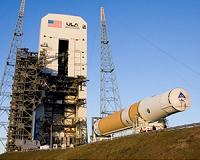 |
95th Air Base Wing Public Affairs Edwards AFB CA (AFNS) Feb 10, 2010 Cadets from the United States Air Force Academy and members of the Air Force Research Laboratory at Edwards conducted operational testing on the satellite dubbed FalconSAT-5 here Jan. 11 - 22. According to a U.S. Air Force Academy Department of Astronautics press release, the primary mission of the FalconSAT-5 is to perform space weather measurements with on-board sensors in collaboration with remote ground sites. The FalconSAT-5 mission spacecraft is being integrated and flown by the Department of Defense Space Test Program and is supported by AFRL. "We are doing full operational testing of the satellite, so we're testing out all of the sub-systems, including the thruster, which is the AFRL-provided payload," said Brian Beal, an AFRL program manager. The testing occurred in AFRL's recently upgraded Space Propellants Environmental Facility, or SPEF, which is a 30-foot-diameter, spherical vacuum chamber. The large physical size of the chamber and high vacuum pumping speed enabled FalconSAT-5 to be tested in conditions that closely mimic the space environment. Though the FalconSAT-5 mission is sponsored by AFRL, it is not the first instance of U.S. Air Force Academy and AFRL cooperation. "AFRL has a long history of working with the Air Force Academy," said Daron Bromaghim, an AFRL program manager. "We send them resources and get some cadets involved in some of the programs that we have, so this [testing project] is just a natural outgrowth of that long history." The history of collaboration is based on the mutual benefit for both organizations as well as the benefit to the Air Force. "From AFRL's perspective, it's great because we get ... a lot of good talent, good resources and innovative thinkers," said Mr. Bromaghim. The talent and dedication of the cadets is essential for the effort and timeline needed for the FalconSAT projects. "The program itself, end to end, has been a couple of years in the making, which, for a satellite program, is pretty fast, from start to finish. To be able to say that we've started with a blank sheet of paper and get a satellite out of the other end two years later is pretty phenomenal, so these cadets and faculty have done a stupendous job," said Mr. Bromaghim. Mr. Bromaghim said the multidisciplinary project creates more hands-on experience in the fields encompassed in the project. From operations to finance, engineering and program management, Air Force critical needs in the space profession are addressed through the FalconSAT program. The benefits for the U.S. Air Force Academy cadets are evident in the lessons they learn from the FalconSAT-5 mission. "It's a good experience," said Cadet Matthew Knutson, Avionics and Analysis Team member with Squadron 21. "I think it'll definitely help when we get into the operational Air Force. It lets us see what real facilities the Air Force has and it gives us real-world experience." Operational Air Force facilities and hands-on experiences ensure that cadets, faculty, and collaborating organizations all play a role in furthering the Air Force space mission. "We're doing real science [and] real technology development for the Air Force and Department of Defense at a low cost. But also, more importantly, we're creating a cadre of space professionals [through] the hands-on experiences that these cadets get in this program," said Col. Tim Lawrence, Space Systems Research Center director. Colonel Lawrence also stated that the FalconSAT-5 program is a huge value to the Air Force and DoD because of the cost efficiency in the cooperation between AFRL and the U.S. Air Force Academy. "We're an undergraduate school doing graduate work on satellites for a real Department of Defense purpose," said Cadet Bill Percoski, FalconSAT-5 Operations Team lead and Operational Test manager with Squadron 40.
Share This Article With Planet Earth
Related Links USAF Academy Space Technology News - Applications and Research
 GOES-P Spacecraft Being Processed In Florida
GOES-P Spacecraft Being Processed In FloridaGreenbelt MD (SPX) Jan 18, 2010 During the first three weeks in January, the latest in the series of Geostationary Operational Environmental Satellites also known as GOES-P is being processed and prepped for launch. Meanwhile, the first and second stages of the Delta IV rocket that will carry it into orbit, are being assembled on the launch pad. The GOES-P spacecraft is currently being processed at Astrotech Space Operat ... read more |
|
| The content herein, unless otherwise known to be public domain, are Copyright 1995-2010 - SpaceDaily. AFP and UPI Wire Stories are copyright Agence France-Presse and United Press International. ESA Portal Reports are copyright European Space Agency. All NASA sourced material is public domain. Additional copyrights may apply in whole or part to other bona fide parties. Advertising does not imply endorsement,agreement or approval of any opinions, statements or information provided by SpaceDaily on any Web page published or hosted by SpaceDaily. Privacy Statement |